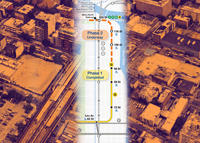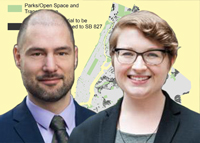The pandemic has cleared out New York’s famously crowded subway, and many commuters are reluctant to return.
But as the city nears phase two of its reopening plan, transit experts say there are ways to save the struggling system — and the real estate that depends on it.
“We’re going to have to figure out ways to change how people travel on the subway,” said Bob Previdi, a transportation policy adviser who spent 14 years at New York City Transit. Practical steps include requiring all passengers to wear masks and establishing a “second peak,” perhaps at 11 a.m., to spread out the crush of people traveling at one time, he said.
Read more


Blogger Ben Kabak, who joined Previdi and Nick Sifuentes, executive director of the Tri-State Transportation Campaign, on an episode of TRD Talks Monday, said there were misconceptions about transit systems being hot spots for the spread of coronavirus.
“This isn’t to say that we don’t know that it can spread on transit, but we haven’t seen any studies that really pinpoint transit usage as a spreader event,” Kabak said.
All three panelists were optimistic that New Yorkers could ride safely with the right precautions, but they agreed that travelers need to change their behavior. That includes limiting talking (and singing and preaching), to avoid sending invisible clouds of virus particles through subway cars.
But the onus is not just on riders: Previdi and Sifuentes said businesses must help revive the subway, such as by staggering work hours and encouraging remote work where possible.
Since the outbreak, Gov. Andrew Cuomo has ramped up cleaning efforts of the subway cars, including shutting down service between 1 a.m. and 5 a.m. for disinfecting. Previdi said making the policy permanent could make sense.
Sifuentes disagreed. “I think it’s actually a huge problem,” the advocacy group leader said. Nightlife and entertainment rely on the Metropolitan Transportation Authority resuming overnight service, he argued, as do essential workers.
Furthermore, the focus on cleaning surfaces neglects the greater concern of crowding and the risk of respiratory transmission that comes with it.
“The real reason the MTA jumps on [cleaning] is this is something they can do,” Previdi said. “This was something in their wheelhouse that they are comfortable with. They are not comfortable managing crowds. They’ve never been comfortable managing crowds.”
In addition to the uncertainty around best practices, finances have become a huge concern. The absence of commuters has created a massive hole in the operating budget of the MTA, which was already facing huge capital costs before the pandemic.
If federal support cannot be secured, Kabak predicted, the discussion would turn to fare hikes and budget cuts.
However, the Second Avenue Sagas author said, “you can’t raise fares [enough] to cover a $10 billion, 18-month budget gap and then expect people to still ride.”
The subways were heavily dependent on fare revenue before the pandemic reduced daily ridership to under 1 million from about 5.5 million. The MTA’s commuter rail lines, Metro-North and the Long Island Rail Road, have suffered even greater drops in ridership because their largely suburban users are less likely to be essential workers and can often work from home.
“Ultimately it’s either going to be a situation where the MTA takes on even more massive amounts of debt,” Kabak said, “or the federal government comes through and delivers the money they need.”
Write to Sylvia Varnham O’Regan at so@therealdeal.com